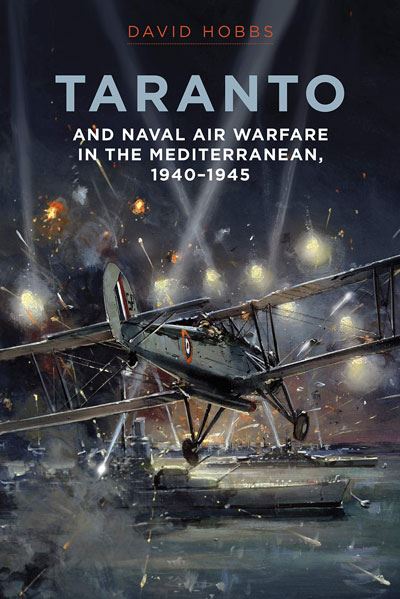Taranto and Naval Air Warfare in the Mediterranean, 1940-1945
David Hobbs
 The battle of Taranto, fought November 11-12, 1940 is probably the most famous battle involving carrier aircraft in the Mediterranean during World War II. It was far from the only one. Taranto and Naval Air Warfare in the Mediterranean 1940-1945, by David Hobbs, tell the story of that battle, and the rest of the Royal Navy Fleet Air Arm’s war in the Mediterranean during World War II.
The battle of Taranto, fought November 11-12, 1940 is probably the most famous battle involving carrier aircraft in the Mediterranean during World War II. It was far from the only one. Taranto and Naval Air Warfare in the Mediterranean 1940-1945, by David Hobbs, tell the story of that battle, and the rest of the Royal Navy Fleet Air Arm’s war in the Mediterranean during World War II.
While Taranto is featured in the title, it is only a small part of this book. It may not have been the most important part. This should not imply Hobbs stinted coverage of that battle. He offers a comprehensive account and analysis of Taranto. It takes up only 41 pages in a 456 page book.
Comprehensive is not a word applicable just to that chapter. It describes the whole book. Hobbs’s account begins with the opening of hostilities in the Mediterranean. It ends with the final Mediterranean operations of World War II in 1945.
In addition to Taranto, Hobbs presents the role British naval aircraft played throughout 1940, including the preliminary activities immediately after Italy declared war on Britain and France and their role during the Battle of Matapan. This also includes actions against the French at Mers El Kébir.
In 1941 he shows how Royal Navy aircraft were involved in the fighting in the Western Desert of Libya and Egypt, the Levant in Syria and in the Balkans supporting Greece. Naval aircraft is a more appropriate term than carrier aircraft. Hobbs shows land-based squadrons and warship floatplanes played a surprising diverse and important role during that year.
The year 1942 includes descriptions of naval aircraft support of Operation Torch and the El-Alamein operations, and the Malta’s reprovisioning. The book reaches its climax during Operation Pedestal, the August 1942 operation to get a supply convoy to Malta. Pedestal was a major carrier effort, directly involving three Royal Navy aircraft carriers and indirectly engaging two others. It was the most decisive carrier action in the Mediterranean, even though the Axis only used land-based aircraft.
Royal Navy aircraft support of Sicilian and Italian invasions were the highlights of 1943, while carrier support of the Southern France invasion and of landings in Greek islands and mainland are the focus of 1944. This is not a dramatic as previous years, if only because allied victory seems assured. Additionally, the less-glamorous escort carriers displaced the faster fleet carriers over these two years as Axis naval and air threats waned.
Hobbs goes beyond just describing operations. He offers insightful analysis of the Royal Navy and its carrier activities during this period. He explains the reasons for the material shortages debilitating fleet aviation from 1939 through 1942. He gives the impression Taranto was originally viewed as an attempt to divert Italian attention, which exceeded beyond expectations.
Taranto is an excellent addition to the series of books Hobbs has written involving Royal Navy aviation operations. It will not interest pure model-makers. For those whose interests lie in history or wargaming, especially those interested in World War II naval aviation, this book is worth reading.
- Barnsley: Seaforth Publishing, 2020
- Annapolis: Naval Institute Press, 2020
- 6-1/2” x 9-1/2”, hardcover, xiv + 440 pages
- Photographs, maps, appendices, notes, bibliography, index. $52.95
- ISBN: 9781526793836
Reviewed by Mark Lardas, League City, Texas
